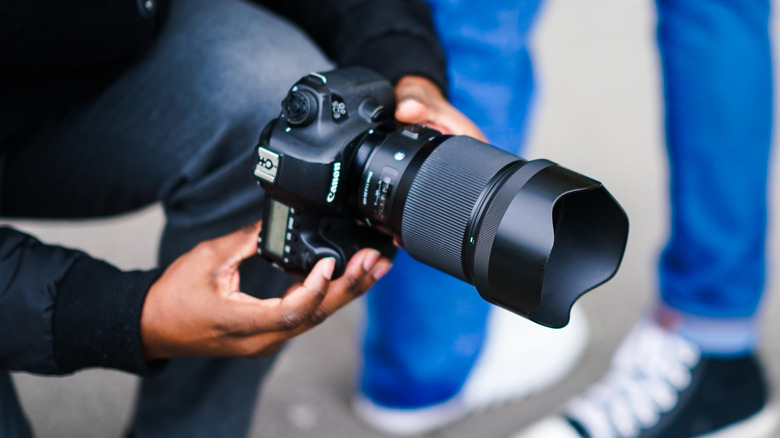What Does 'DSLR' Actually Mean On A Camera?
The term "DSLR" stands for Digital Single-Lens Reflex and describes the mechanics behind how this type of camera works. But the name alone doesn't really explain what's going on inside the shell or casing of the camera. What does this technology actually do? How does it differ from other types of cameras or photography equipment? More confusingly, DSLR has become synonymous with many modern digital cameras and is used to describe them in general, when really, there are several types of digital camera technologies in play. The sheer variety of camera styles is really what makes DSLRs so popular, as they're lightweight, versatile options compared to some alternatives.
A DSLR camera has a fixed, digital sensor capable of autofocus that works great in low-light settings and complex environments. When using a DSLR camera, the photographer looks through the optical viewfinder at what they're shooting, which is reflected by a mirror. When they press the shutter button, the mirror swings and sends light into the digital image sensor, which records the image and digitally saves it to the camera's SD card. Another form of digital camera, called a mirrorless camera, works similarly except, as the name implies, there's no mirror. The light from the lens passes directly to the sensor, and the photographer sees a representation via an electronic viewfinder or an LCD screen.
Comparatively, the DSLR design gives it a few advantages over mirrorless cameras. For instance, since DSLRs don't need a screen on all the time, they use less battery power, making DSLR cameras a go-to choice for remote field work. Furthermore, their high-quality image capture technology outperforms smartphone cameras, though some phones are incorporating better tech, like the Astrophoto feature on Samsung Galaxy phones.
Additional DSLR camera properties that matter
Thanks to a large image sensor that is capable of capturing more light, DSLR cameras are excellent in low-light conditions and difficult environments. They also tend to have better autofocus than basic point-and-shoot cameras. DSLR cameras also focus faster and more reliably for clearer, high-quality pictures. Then there's the DSLR camera's battery life boost, because it's not using electronics like an electronic viewfinder or LCD screen as much — most DSLRs still have a screen you can use to preview shots. Furthermore, the compact design overall makes DSLR cameras better suited for travel and field work conditions versus traditional cameras. Naturally, cameras are easier to pack and carry when they're small and lightweight. Although that can change depending on the type of lens you use.
DSLRs aren't all positives. There are drawbacks to using a DSLR versus a mirrorless camera. With the latter, the viewfinder shows an accurate representation of the final image. DSLR, on the other hand, introduces exposure discrepancies because of the mirror, meaning the final shot might look different. The colors, brightness, and exposure may be off in the final image. DSLR captures may need edits before they're in line with your vision. It's not a huge issue, but it's relevant, especially when taking professional photos. Moreover, mirrorless cameras are comparatively lighter and more compact because the camera body doesn't accommodate a mirror. These cameras also work better with video capture, especially in HD, as the DSLR's mirror can make focusing real-time and moving shots difficult. You'd probably want to use something like the GoPro Hero compact camera for action shots. That said, most used DSLR cameras that are actually worth buying hold their value well as long as they're properly maintained.

